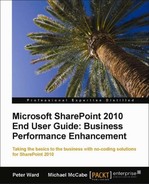Chapter 1, Where Should End Users Start with SharePoint? identifies the typical end user and discusses information and technology considerations with the SharePoint technology.
Chapter 2, SharePoint Essentials covers fundamental essentials that the end users should know about SharePoint technology and how it is relevant to them.
Chapter 3, SharePoint Team Sites begins to further introduce the key SharePoint components to help you understand what SharePoint Team Sites (Sites) are and what purposes content and information in a Site provide. This will ultimately allow you to architect an entire portal.
Chapter 4, List Management helps you to gain knowledge of List Management and understand how to track information and learn efficient ways to store this information for business activities.
Chapter 5, Library Management explains Library Management, how files can be stored and managed, and how to collaborate on documents with team members. The integration with Office and SharePoint is introduced.
Chapter 6, Workflows Fundamentals explains workflows and how these benefit the business world, both in terms of streamlining office functions as well as cutting costs. The chapter explains the workflows options available with different SharePoint versions and how to integrate workflows modeling using Visio 2010 SharePoint Designer.
Chapter 7, Office Integration with SharePoint builds on the functionality explained in previous chapters and explains the integration between this functionality and the Microsoft Office 2010 client applications. It covers Ribbon Interface, Office Web Apps, Co-Authoring, Social Computing, Backstage, Slide Show Broadcasting, Visio Web Services, and SharePoint Workspaces. The chapter also identifies time saving techniques of integrating Office and SharePoint technology for tasks and activities.
Chapter 8, Managing Metadata explains both the basic terminology and concepts of metadata, and where and how to apply it to both hierarchical taxonomies and to unstructured folksonomies. Administrative tools for managing hierarchical taxonomies are reviewed.
Chapter 9, Getting Better Search Results with SharePoint 2010 introduces SharePoint search functionality such as wildcard and phonetic searches, and how to customize search results.
Chapter 10, Alerts and Notifications explains SharePoint's alert capabilities and why this important functionality is often overlooked by end users. Alert management in Outlook is also discussed.
Chapter 11, Enterprise Content Management discusses SharePoint's functionality in managing content with procedures to ensure accurate, up-to-date, and compliant content. The chapter's main functionality discussion points are record management, content types, and information management policies. Other discussion points include how to organize and promote true enterprise-wide content management and the challenges to do this in an organization.
Chapter 12, Blogs, Wikis, and Other Web 2.0 Features further explains the new SharePoint 2010 Web 2.0 features to create and share information collaboratively on the web. The Web 2.0 functionality discussed includes blogs, tagging, comments, wikis, and ratings.
Chapter 13, Pages and Web Parts will extend previously introduced functionality by explaining how page customization can be done by the user, without code. This introduces personalization to the user experience.
Chapter 14, My Sites explains My Sites and how they assist users to keep track of their personal content and information, along with discovering information about other users. This chapter's objective is to make you aware of the importance of My Sites and to ensure you learn how to effectively use them in your organization.
Chapter 15, Applying Functionality for Business Initiatives discusses where SharePoint's functionality can be applied to business areas in an organization, such as Sales Department, IT Department, Project Management Office, and Human Resources. The chapter also introduces functionality that is most appropriate to users' main collaboration activity.
Chapter 16, Creating Exceptional End User Experience for You and Your Team looks at where SharePoint's functionality can be applied to give exceptional user experience to lists, libraries, notifications, search, pages, team sites, and My Sites. What is exceptional end user experience is discussed and how this can be applied to a SharePoint deployment. Other topics covered include tips and techniques on how to apply SharePoint functionality, as explained in the previous chapters.
Chapter 17, Golden Rules for End User Deployment outlines what SharePoint is not, what is special about SharePoint, why there is considerable value in using this technology, and the User Requirement Challenges that a deployment will cause.
Appendix A, Glossary, provides definitions to many terms and acronyms related to SharePoint end user functionality, corporate intranets and web user interface.
Appendix B, SharePoint Functionality Comparison gives a functionality comparison of SharePoint's Foundation and Server versions, along with the functionality differences to SharePoint Standard and Enterprise editions.
Appendix C, List Templates gives a functionality comparison of SharePoint's available out of the box list and library functionality as well as business scenarios of when to use each type of list and library.
